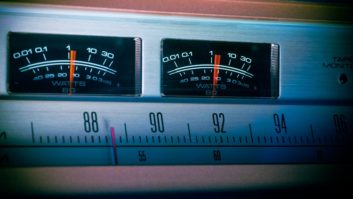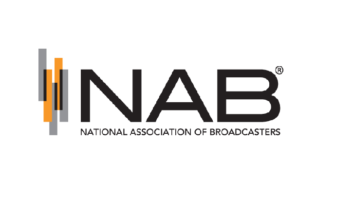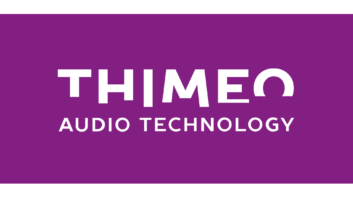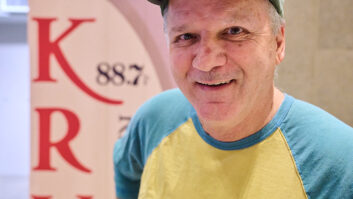You have decided to get into the free-lance voiceover/tracking business and are shopping for an appropriate mixer.
Product CapsuleThumbs Up
Lots of dedicated stereo inputs
RIAA phono preamps
Long-throw linear faders
Good cost-to-feature ratio
Thumbs Down
Plastic shafts on pots
Why no Auxiliary Returns?
Price: $599.95
Contact: The Soundcraft Group in California at (888) 251-8352 or visit www.soundcraft.com
Or maybe you convinced management that the station’s now-unused prize closet might make an effective backup or second production room.
(click thumbnail)
Either way, it is time to land a mixer that can be installed quickly, sounds good and offers a decent feature set. Enter the Spirit ES mixer ($599.95), part of the Spirit E Series from England-based Soundcraft, distributed domestically by The Soundcraft Group.
While not a broadcast-specific board, the ES reverses the concept of the typical small mixer — normally lots of mono mic inputs and a token amount of stereo line ins — and instead offers up four mics and 10 stereo inputs.
This assures plenty of stereo mixing capacity to start with and to grow with, in an attractive case with a powdered metal-type finish.
A fair comparison
In small room layouts, a mixer like the venerable Mackie 1604 generally is the first choice, for many good reasons.
It connects to almost anything, is forgiving of incoming levels, has lots of extras and has four busses going out. Many a home studio and small production space have been outfitted with this mixer. And with 16 inputs, it would be in use for awhile before being maxed out with additional sources.
Or would it? Because each stereo source would occupy two faders, the capacity of the mixer is halved – down to eight stereo inputs. Add the need for, say, two microphones, and the ability for that 16-channel monster to handle multiple stereo sources plummets to seven.
When you have a PC soundcard, two CD decks, a cassette and/or a MiniDisc machine, a DGS receiver box and a feed from another studio to worry about, you start feeling the squeeze.
Then there is the redundancy of having two sets of pan controls, two sets of EQ strips and more Aux sends than you may ever need, per stereo source. An awful lot of that mixer is going to go unused.
This is not a slam against Mackie. The 1604 is one of the most popular and visible mixers in the audio industry. It is just that, for broadcast production purposes, we are likelier to require dedicated stereo inputs and a single set of EQ and Aux controls per input. Plus, with four-track tape recorders practically a thing of the past, four-bus operation is no longer a major consideration.
The Spirit ES offers a feature set that is considerable, although limited in some ways, which I will explain; and there is enough broadcast-familiar operation to it (such as a way to do cueing) to make it simple for any broadcaster to operate.
Close look
As noted, the Spirit ES worksurface is steel, with an attractive powdered metal finish. The surface appears durable; this is negated, however, by the plastic shafts of the rotary pots. The panel may take a beating, but the shafts could snap and strip in an impact. While designed to be portable, this is not a “toss in the truck” kind of mixer.
Speaking of portability, the ES has it over the more boxy and angular Mackie 1604 with a front wrist rest that doubles as a carry handle. The curved front curls underneath into a comfortable lip that makes it easy to grab and go.
Linear faders are 100 mm types and are undamped, lacking the viscous feel of those on the Mackie unit.
Connections are made to jacks along the rear of the top panel. While handy, I still prefer jacks on the rear panel; for one thing, the wiring and patching is concealed; and a spilled coffee won’t pour down into the mixer’s guts through open jacks.
The surprise is where Soundcraft engineers hid the power plug: under the mixer, next to an enormous grounding stud on the chassis. Creating star grounds to the ES will not be an effort, believe me.
Mute ItOne complaint when using small, nonbroadcast mixers in a broadcast environment is that there is no mic mute logic. Turn up a mic input and get feedback.
Many users simply make it a habit to turn down the monitor speaker when opening the mic, but this is an unnecessary compromise. What is needed is a Channel On switch to activate the mic and cut the monitors, just like in the main studio.
Broadcast Tools makes the CCIIA console controller, which offers full mute logic for three microphones and trips an on-air light when in use. We use two of these in studios at the Connecticut Schools of Broadcasting campus in Washington.
For occasions where only one microphone will be in use, use a 4PDT toggle switch mounted in a small Bud case or plastic box.
One pole interrupts the mic signal fed to and from the mixer’s Insert jack, two poles carry monitor audio from the mixer to the amplifier and the fourth is tied to a low-voltage relay, which remotely activates a tally light.
In use, throwing the switch disconnects the feed from the mixer to the amp, while simultaneously switching on the mic and the tally light relay. For safety, do not run 120 VAC directly through this switch.
— Alan Peterson
The four mono inputs share similar features. Each have XLR and quarter — inch jacks for mic and line — level signals, an Insert jack for outboard processing or muting interrupt (see sidebar), gain trimmer, three-stage EQ, two Aux Sends and a panpot.
Solo and Mute buttons and a Peak LED round out the mono input strips. A phantom power button activates +48V on all mono channels.
The shelving Low Frequency EQ offers ±15 dB and turns the corner at 80 Hz, which is appropriate for cutting room rumble. You can put more bass power behind a male voice on mic, but you are boosting everything in that range.
For adding more punch to the human voice however, you might be better off with the Mid EQ stage, offering ±15 dB, sweepable between 140 Hz to 3 kHz with a fixed Q of 1.5. The High Frequency EQ does its magic around 12 kHz.
The mono inputs are the only place you will find sweepable mids. The EQ on the stereo channels has a centered frequency of 600 Hz.
A lot of thought went into what kind of gear would be connected to the Spirit ES. For example, Stereo Inputs 1 and 2 have RIAA — equalized turntable inputs included — no need for an external preamp. Channels 3 through 6 have RCA phono jack inputs as well as quarter-inch balanced inputs (the jacks override the RCA inputs when used).
Gain trimmers are on each stereo input. You never know what those factory-set levels on that MD deck are going to be sometimes, right?
And last, each stereo input can also be a mono input if needed. Plug into the Left channel only, press a Mono button (on inputs 3 through 6 only) and you can now have 10 mono line-level channels if desired.
O Solo Mio
In broadcast use, there is hardly ever the need for Solo and Mute buttons on a console — Soloing and Muting production tracks generally is done inside the DAW — but both offer broadcast-like functionality that many may not have thought of.
When depressed, Mute buttons behave as Channel Off keys. Ramping a fader up or down would have no effect with the Mute button in.
This is generally not used in this manner, as these buttons are so small they can be ignored or entirely missed. Plus, buttons of this type are of light construction, and we all know how broadcasters like to wallop switches.
The Solo buttons can be used to cue up new audio. Pressing a Solo button puts a source up in the speakers and headphones without sending it to the mix outputs. It doesn’t feel the same as a dedicated Cue button and speaker, but it is a reasonable use of this feature.
As mentioned, there are two Auxiliary Sends that can send pre — or post — fader signals to an outboard processor. Trouble is, there are no Aux Returns on the Spirit ES. Again referring to the Mackie 1604, there are corresponding Sends and Returns that provide a completed path for any audio directed out of the mixer for secondary processing and a return to the mix.
Maybe it is a common aspect to the general design of British consoles; I own an Allen & Heath WZ20S mixer that has six Aux Sends, but likewise lacks a single Return. It is assumed the Return audio will be sent to an unused input channel.
As it is, we do not find ourselves using Aux Sends much in the studio anyway. Basic mic processing can be done through the Insert jack on the respective channel, and most fancy trickery is now done inside the DAW.
If there would be a primary use for the Aux Sends on the Spirit ES, it would be as an improvised mix-minus to feed a phone hybrid or a PA feed at a live remote. No return would be needed then.
Wrap-up
To their credit, Soundcraft engineers included lots of diagrams of cables and their connections. Not everyone knows exactly how to fabricate a balanced XLR-to-unbalanced phono plug connector. The ES manual includes two dozen diagrams of adapter cables that you should know how to wire up and use.
The manual also shows its U.K. roots by its use of terms such as “3-pole A gauge jacks,” better known as quarter-inch TRS plugs here in the colonies, and “75R” to indicate output impedance. The manual also includes a warning about high SPLs in headphones. Bravo.
Looking for a more permanent mount for the ES? The side wings come off, making way for rackmount brackets. Put it in an equipment rack or get someone to make a set of decorative wood wings so it looks more like a broadcast board.
As a mixer for home studio/tracking use or even as a board for an auxiliary production room, the Spirit ES is a good performer with the right features, a reasonable alternative to the popular Mackie 1604 for broadcast-type production. It lets you have real stereo inputs without eating up two faders in the process.
The absence of Auxiliary Returns and the relative fragility of the plastic pot shafts are my only real concerns. Again, how often do we need an Aux Send and Return anyway, and as long as the mixer is not trucked around or situated under a PC monitor or speaker that may topple, we should be okay.
Small rooms call for small mixers. But that does not mean they should be devoid of features. The Soundcraft Spirit ES mixer fills a need you may be experiencing even now.













